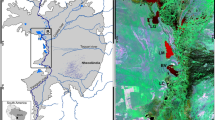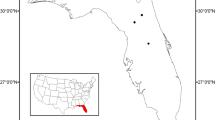Abstract
The stable isotopic composition (δ13C) of sediments from lakes are frequently analyzed to reconstruct the proportion of the regional vegetation that used either the C3 or C4 photosynthetic pathways, often without conducting a detailed survey of the current local vegetation. We performed a study on the modern vegetation composition within the Wolfe Creek Meteorite Crater to complement our future paleoecological investigation of the crater. A bull’s-eye pattern exists where C4 grasses dominate an outer ring and salt tolerant species, including shrubs, herbs, chenopods, and halophytic algae, dominate the inner pan of the crater. The ecotone between the inner and outer zones is narrow and occupied by tall (>7 m) Acacia ampliceps, with some C4 grasses in the understory. Along with the highest water table and most saline soils the center of the crater has C3 plants present with the highest δ13C and δ15N values. The range of δ13C and δ15N values from the analysis of surface soil organic matter (OM) was much smaller compared with the range of values from plant materials implying that either: (1) the current plant OM has not yet been integrated into the soils, or (2) processes within the soil have acted to homogenize isotopic variability within the crater. The application of a two end member mixing model to calculate %C4 and %C3 biomass from the δ13C of surface soil OM was complicated by: (1) the crater containing both a dry habitat with C4 grasses and a central pan with C4 halophytic plants and, (2) the large variation in the δ13C of the plants and soil OM.







Similar content being viewed by others
References
Allan RJ (1985) The Australian summer monsoon, teleconnections, and flooding in the Lake Eyre Basin. Royal Geographic Society of Australasia (South Australian Branch), Adelaide
Archibold OW (1995) Ecology of world vegetation. Chapman and Hall, London
Australian Department of Agriculture (2003) Salinity tolerance of plants for agriculture and revegetation. http://www.agric.wa.gov.au/environment/land/salinity/measurement/Plant_salt_tolerance.html
Bajji M, Kinet JM, Lutts S (1998) Salt stress effects on roots and leaves of Atriplex halimus L. and their corresponding callus cultures. Plant Sci 137:131–142
Bird MI, Pousai P (1997) Variations of delta C-13 in the surface soil organic carbon pool. Global Biogeochem Cycles 11(3):313–322
Bowler JM (1981) Australian salt lakes: a palaeohydrological approach. Hydrobiologia 82:431–444
Bowler JM (1986) Spatial variability and hydrologic evolution of Australian Lake Basins—analog for pleistocene hydrologic change and evaporite formation. Palaeogeogr Palaeoclimatol Palaeoecol 54:21–41
Bowler JM, Johnston H, Olley JM, Prescott JR, Roberts RG, Shawcross W, Spooner NA (2003) New ages for human occupation and climatic change at Lake Mungo, Australia. Nature 421:837–840
Brennan RF, Webb MG, Crowhurst AM (2000) Yield responses of mulla mulla (Ptilotus exaltatus Nees.) seedlings to additions of nitrogen, potassium and phosphorus fertiliser. Aust J Exp Agric 40:867–871
Bull ID, Nott CJ, van Bergen PF, Poulton PR, Evershed RP (2000) Organic geochemical studies of soils from the rothamsted classical experiments-VI. The occurrence and source of organic acids in an experimental grassland soil. Soil Biol Biochem 32:1367–1376
Cantero JJ, Leon R, Cisneros JM, Cantero A (1998) Habitat structure and vegetation relationships in central Argentina salt marsh landscapes. Plant Ecol 137:79–100
Cassidy WA (1954) The wolf creek, Western Australia, meteorite crater. Meteoritics 1:197–199
Commonwealth Bureau of Meteorology A. (2003). Climate information, http://www.bom.gov.au/climate/
Deines P (1980) The isotopic composition of reduced organic carbon. In: Fontes JC (ed) Handbook of environmental isotope geochemistry. Elsevier, Amsterdam, pp 187–221
Ehleringer JR (1991) 13C/12C Fractionation and its utility in terrestrial plant studies. In: B Fry (ed) Carbon isotope techniques. Academic, New York, pp 187–200
Ehleringer JR, Cerling TE, Helliker BR (1997) C-4 photosynthesis, atmospheric CO2 and climate. Oecologia 112:285–299
Erskine PD, Bergstrom DM, Schmidt S, Stewart GR, Tweedie CE, Shaw JD (1998) Subantarctic Macquarie Island—a model ecosystem for studying animal-derived nitrogen sources using 15N natural abundance. Oecologia 117:187–193
Evans RD (2001) Physiological mechanisms infleuncing plant nitrogen isotope composition. Trends Plant Sci 6(3):121–127
Farquhar GD, Ball MC, Caemmerer S von, Roksandic Z (1982) Effect of salinity and humidity on δ13C value of halophytes—evidence for diffusional isotope fractionation determined by the ratio of intercellular/atmospheric partial pressure of CO2 under different environmental conditions. Oecologia 52:121–124
Ficken KJ, Wooller MJ, Swain DL, Street-Perrott FA, Eglinton G (2002) Reconstruction of a subalpine grass-dominated ecosystem, Lake Rutundu, Mount Kenya: a novel multi-proxy approach. Palaeogeogr Palaeoclim Palaeoecol 177:137–149
Giraud SA, Samba E, Lajudie R, Gillis Pd, Dreyfus B (2001) Certaines légumineuses du genre Crotalaria sont spécifiquement nodulées par une nouvelle espèce de Methylobacterium. Can J Microbiol 47:503–508
Guppy DJM, Matheson RS (1950) Wolf Creek meteorite crater, Western Australia. J Geol 58:30–36
Handley LL, Raven JA (1992). The use of natural abundence of nitrogen isotopes in plant physiology and ecology. Plant Cell Environ 15:965–985
Harris D, Horwath WR, van Kessel C (2001) Acid fumigation of soils to remove carbonates prior to total organic carbon or carbon-13 isotopic analysis. Soil Sci Soc Am J 65:1853–1856
Johnson BJ, Miller GH, Fogel ML, Magee JW, Gagan MK, Chivas AR (1999) 65,000 years of vegetation change in central Australia and the Australian summer monsoon. Science 284:1150–1152
Jones RI, King L, Dent MM, Maberly SC, Gibson CE (2004) Nitrogen stable isotope ratios in surface sediments, epilithon and macrophytes from upland lakes with differing nutrient status. Freshwater Biol 49:382–391
Kadner R (1998) Influence of light intensity on vegetative growth of Ptilotus exaltatus R Br. Gartenbauwissenschaft 63:152–156
Kendall C (1988) Tracing nitrogen sources and cycling in catchments. In: McDonnell JJ (ed) Isotope tracers in catchment hydrology. Elsevier, Amsterdam, pp 519–576
Khan MA, Ungar IA, Showalter AM (2000) Effects of salinity on growth, water relations and ion accumulation of the subtropical perennial halophyte, Atriplex griffithii var. stocksii. Ann Bot 85:225–232
Krull ES, Baldock JA, Skjemstad JO (2003) Importance of mechanisms and processes of the stabilisation of soil organic matter for modelling carbon turnover. Funct Plant Biol 30(2):207–222 2003
de Lange PJ, Norton DA, Crowcroft GM (2000) Taxonomy, ecology, and conservation of Atriplex billardierei and A-hollowayi sp, nov (Chenopodiaceae) in Australasia. N Z J Bot 38:551–567
LaPaz L (1954) Meteoritic material from the wolf creek, Western Australia, Crater. Meteoritics 1:200–203
Lin G, Sternberg LDL (1992) Effect of growth form, salinity, nutrient and sulfide on photosynthesis, carbon isotope discrimination and growth of red mangrove (Rhizophora-mangle L). Aust J Plant Physiol 19:509–517
Lockhart C, Austin DF, Aumen NG (1999) Water level effects on growth of Melaleuca seedlings from Lake Okeechobee (Florida, USA) littoral zone. Environ Manag 23:507–518
Macko SA, Parker PL (1993) Early diagenesis of organic matter in sediments: assessment of mechanisms and preservation by the use of isotopic molecular approaches. In: Engel MH, Macko SA (eds) Organic geochemistry. Plenum Press, New York, pp 211–224
McCall GJH (1965) Possible meteorite craters—wolf creek, Australia and analogues. Ann N Y Acad Sci 123:970–998
McKee KL, Feller IC, Popp M, Wanek W (2002) Mangrove isotopic (delta N-15 and delta C-13) fractionation across a nitrogen vs. phosphorus limitation gradient. Ecology 83(4):1065–1075
Meyers PA, Ishiwatari R (1993) The early diagenesis of organic matter in lacustrine sediments. In: Engel MH, Macko SA (eds) Organic geochemistry. Plenum Press, New York, pp 185–209
Miller GH, Magee JW, Johnson BJ, Fogel ML, Spooner NA, McCulloch MT, Ayliffe LK (1999) Pleistocene extinction of Genyornis newtoni: human impact on Australian megafauna. Science 283:205–208
Mitchell AA, Wilcox DG (1994) Arid shrubland plants. University of Western Australia Press, Perth
Mora G, Pratt LM, Boom A, Hooghiemstra H (2002) Biogeochemical characteristics of lacustrine sediments reflecting a changing alpine neotropical ecosystem during the Pleistocene. Quat Res 58(2):189–196
Naidu BP, Paleg LG, Jones GP (2000) Accumulation of proline analogues and adaptation of Melaleuca species to diverse environments in Australia. Aust J Bot 48:611–620
O´Leary MH (1988) Carbon isotopes in photosynthesis: fractionation techniques may reveal new aspects of carbon dynamics in plants. Bioscience 38(5):328–336
Pack SM, Miller GH, Fogel ML, Spooner NA (2003) Carbon isotopic evidence for increased aridity in northwestern Australia through the quaternary. Quat Sci Rev 22:629–643
Pelheram RJ, Kok B (1991) Plants of the Kimberley Region of Western Australia. University of Western Australia Press, Nedlands
Reeves FC, Chalmers RO (1948) Wolf creek crater. Aust J Sci 11:154–156
Roberts RG, Jones R, Smith MA (1990) thermoluminescence dating of a 50,000-year-old human occupation site in northern Australia. Nature 345:153–156
Roberts RG, Jones R, Spooner NA, Head J, Murray AS, Smith MA (1994) The human colonization of Australia: optical dates of 53,000 and 60,000 years bracket human arrival at deaf adder gorge, Northern Territory. Quat Sci Rev 13:575–583
Roberts RG, Flannery TF, Ayliffe LK, Yoshida H, Olley JM, Prideaux GJ, Laslett GM, Baynes A, Smith MA, Jones R, Smith BL (2001) New ages for the last Australian megafauna: continent-wide extinction about 46,000 years ago. Science 292:1888–1892
Robinson D (2001) δ15N as an intergrator of the nitrogen cycle. Trends Ecol Evol 16(3):153–162
Rye BL, Hoch BL, Wilson AJG, Wheeler JR (1992) Flora of the Kimberley Region. Department of Conservation and Land Management, Como
Schweizer MK, Wooller MJ, Toporski J, Fogel ML, Steele A (2005). Examination of an Oligocene lacustrine ecosystem using C and N stable isotopes. Paleogeography, Paleoclimatology, Paleoecology. TBA
Shoemaker EM, Shoemaker CS, Nishiizumi K, Kohl CP, Arnold JR, Klein J, Fink D, Middleton R, Kubik PW, Sharma P (1990). Ages of Australian meteorite craters—a preliminary report. Meteoritics 409
Suppiah R (1992) The Australian summer monsoon—a review. Prog Phys Geogr 16:283–318
Tieszen LL (1991) Natural variations in the carbon isotopic values of plants: implications for archaeology, ecology and paleoecology. J Archaeol Sci 18:227–248
Turney CSM, Bird MI, Fifield LK, Roberts RG, Smith M, Dortch CE, Grun R, Lawson E, Ayliffe LK, Miller GH, Dortch J, Cresswell RG (2001) Early human occupation at Devil’s Lair, southwestern Australia 50,000 years ago. Quat Res 55:3–13
Wallis LA (2000) Preliminary examination of phytoliths recovered from Wolfe Creek Crater, northwest Australia. Department of Archaeology and Natural History Research School of Pacific and Asian Stusies, The Australian National University
Watson L, Dallwitz MJ (1994) The Grass Genera of the World. CAB International, Cambridge
Wooller MJ, Collins B, Fogel M (2001) The elemental analyzer sample carousel: loading an autosampler made easy. Rapid Commun Mass Spectrom 15:1957–1959
Wooller MJ, Smallwood B, Scharler U, Jacobson M, Fogel M (2003a) Towards a multi-proxy approach to mangrove palaeoecology: a taphonomic study of δ13C and δ15N values in R. mangle leaves. Org Geogem 34:1259–1275
Wooller MJ, Swain DL, Ficken KJ, Agnew ADQ, Street-Perrott FA, Eglinton G (2003b) Late Quaternary vegetation changes around Lake Rutundu, Mount Kenya, East Africa: evidence from grass cuticles, pollen and stable carbon isotopes. J Quat Sci 18:3–15
Wooller MJ, Smallwood B, Jacobson M, Fogel M (2003c) Carbon and nitrogen stable isotopic variation in Laguncularia racemosa from Florida and Belize: Implications for trophic level studies. Hydrobiologia 499:13–23
Acknowledgments
We are grateful to the Billiluna aboriginal community, who allowed us to conduct our survey in the WCMC in 1999 and 2001. We also appreciated the assistance given by CALM, not least for allowing us to camp at the crater and for all the support given by their on-site rangers. We thank Gillian Atkin, Monique Belanger, Stephen DeVogel, Paul Hesse, Damian Kelleher, John Magee, Gifford Miller, Elizabeth Miller, Nigel Spooner, and Lynley Wallis for their company and assistance during fieldwork. We thank Gifford Miller and John Magee for surveying the topography of the crater and supplying us with the data from the survey. We also acknowledge Dana Swarth for measuring the moisture content of our soil samples. Our experiments comply with the current laws of the countries in which they were performed. This work was funded by an NSF grant (ATM 0081876 to MLF). We thank Chris Turney and two anonymous reviewers for their constructive and comprehensive suggestions for modifications to our paper.
Author information
Authors and Affiliations
Corresponding author
Additional information
Communicated by Lawrence Flanagan
Rights and permissions
About this article
Cite this article
Wooller, M.J., Johnson, B.J., Wilkie, A. et al. Stable isotope characteristics across narrow savanna/woodland ecotones in Wolfe Creek Meteorite Crater, Western Australia. Oecologia 145, 100–112 (2005). https://doi.org/10.1007/s00442-005-0105-5
Received:
Accepted:
Published:
Issue Date:
DOI: https://doi.org/10.1007/s00442-005-0105-5




